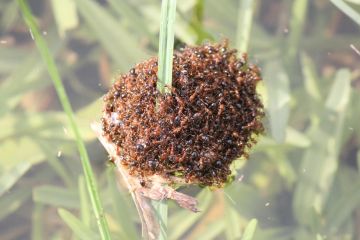Australian households could be slugged with a $581 million annual pesticide bill if fire ant eradication efforts fail, a new report by the Australia Institute has revealed.
The report also provides a breakdown of costs at the electorate level, revealing the impact on communities if fire ants spread across the country.
For example, the marginal Queensland electorates of Blair held by Labor’s Shane Neumann, the Opposition Leader Peter Dutton’s seat of Dickson and Green held Ryan face the following potential annual costs:
- Blair: $1.7 million in medical costs, $1.5 million in vet costs, and $5.1 million in household pesticide costs.
- Dickson: $1.4 million in medical costs, $1.2 million in vet costs, and $4 million in household pesticide costs.
- Ryan: $1.5 million in medical costs, $1.3 million in vet costs, and $3.4 million in household pesticide costs.
‘The experience of the USA shows that without fire ant eradication, the hum of weekend lawnmowers will be joined by the hiss of pesticide sprayers across Australian backyards,’ Invasive Species Council Advocacy Manager Reece Pianta said.
‘Fire ant eradication failure means Australian households could get slugged with a $580 million bill each year as they take fire ant control into their own hands.
‘That’s as much as the current 4-year fire ant eradication program budget every year – forever.
‘This burden would fall on homeowners to treat their backyards, sports clubs to protect their fields and fairways and local councils to protect beaches and parks from fire ants.
‘It’s no surprise that we’re hearing on the ground from politicians and communities that this is shaping up to be a big election issue in Queensland, including in key seats like Blair, Dickson and Ryan.
‘Fire ants aren’t just a financial burden, they’re an environmental and health hazard that will wreak havoc stinging humans, pets, wildlife and livestock alike.
‘In the United States, where fire ants cannot be eradicated, residents in fire ant zones find their neighbours using a range of harsh or off-label chemical treatments to control these killer invaders.
‘Parents are not going to just sit by and let their kids be stung by these tiny killers, so it’s no surprise we hear of stories in the USA of petrol being poured on nests or uncontrolled chemical use.
‘The good news is we can avoid this fate if our politicians commit to complete the fire ant eradication project. This will require all parties to commit to a funding boost for suppression and containment efforts ahead of the coming federal election.
‘Fire ant eradication is a community-wide project. We can all do our part and that includes calling on our politicians to ensure fire ant eradication is completed.
‘We call on all parties at the coming federal election to step up and take decisive action.
‘Prime Minister Albanese and Opposition Leader Peter Dutton should now do their bit to save Australia from fire ants by matching Queensland’s $24 million funding boost to go towards community support and public education – plus commit the $378.56 million needed to fully fund eradication from 2027 to 2031.
‘Long-term fire ant eradication funding beyond 2027 and a funding surge for suppression and containment will mean the difference between success and failure in dealing with fire ants.’
Research Director at the Australian Institute, Rod Campbell said:
‘The economic case for fire ant eradication is a no-brainer.
‘Behind the dollar figures though, is what the money would be spent on – pesticides.
‘Australia needs to eradicate fire ants urgently not just to save money for households, but to avoid huge volumes of pesticides going into our backyards, fields and bushland.’
Media inquiries: (02) 8006 5004
Fire ant images are available here.
Background:
- Fire ants can be lethal to humans, are expected to have a $2 billion per year impact on Australia’s economy if they get out of control, will devastate wildlife, cut agricultural output by up to 40% and may cause over one hundred thousand extra medical appointments each year.
- Fire ants can form rafts during flood events, stowaway in freight or soil or spread by Queen ant flights of around 5 km per year (and up to 30 km in favourable conditions).
- The National Red Imported Fire Ant Eradication Program strategic review estimated that at least $200 to $300 million per year will be required for ongoing eradication efforts to achieve eradication by 2032 – this compares to $94 million spent in 2022/23 and only $60 million committed for this financial year.
- Recently Australia’s governments committed to ongoing fire ant eradication but have not yet committed any new funding to fight fire ants in Australia. Fire ant eradication is being led by the Queensland government but is funded by all Australian governments because fire ants are a threat to the whole country.
- Fire ants came into Australia in the late 90s in freight from the United States, they were found in 2001. Fire ants are originally from South America.
- Fire ants have spread across most of the southern United States, and are spreading in China at a rate of about 80 km per year.
- Almost all of Australia is climatically suitable for fire ants.
- A comprehensive government study from 2021 found that between $200 and $300 million annually would be required over the next 10 years or Australia would face at least a $2 billion cost per year from fire ants forever. At the moment the planned funding is only half that amount.
Contrasting fire ant response methods in Australia and overseas:
Australia’s National Fire Ant Eradication Program primarily uses Insect Growth Regulator treatments delivered in dry corn grit and oil. These use the fire ant foraging instinct to deliver treatments to nests, meaning even those that have not been detected are destroyed. These treatments prevent the development of mature fire ants, so colonies are unable to forage and compete for nutrients. These treatments are considered among the most environmentally friendly options internationally and do not impact humans or animals.
In the United States, insecticide powders or ant dusts and broadcast chemical sprays are often used in suburban and agricultural settings to destroy nests. These treatments must be used each year and can remain active in the soil, blow with the wind to unintended areas and are often used at levels high above label recommendations. These treatments are used to protect humans and animals from persistent fire ant attacks because eradication is not possible.








